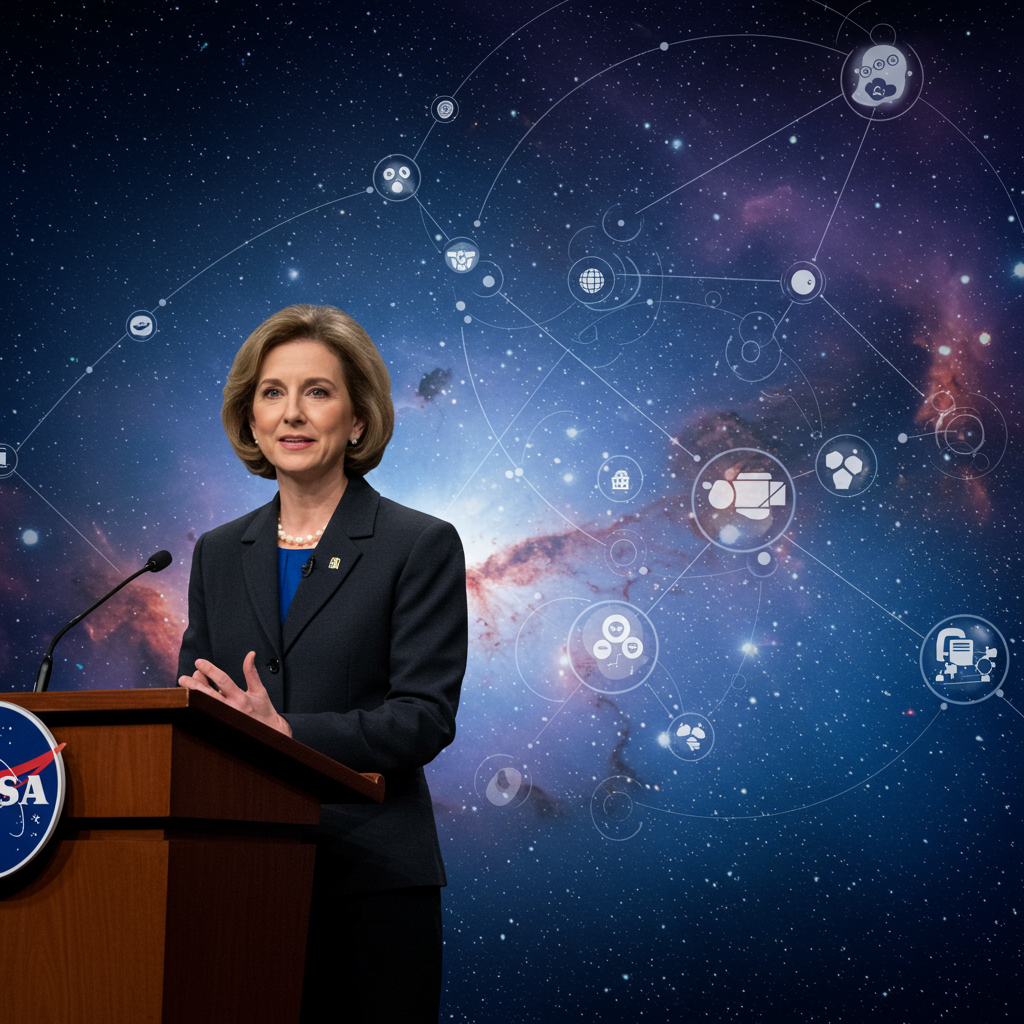NASA’s acting leadership is navigating a complex period. The agency faces significant proposed budget reductions while simultaneously planning a major structural overhaul. Acting Administrator Janet Petro expects to finalize a new “top-level” organizational structure for NASA within weeks. This potential shift aims to reshape how the agency operates and streamline internal reporting lines.
This planned reorganization is a crucial step for NASA’s future efficiency. It coincides with widespread concerns among employees about potential workforce reductions and severe budget cuts outlined in a recent fiscal year proposal. The path forward involves balancing strategic restructuring with fiscal realities and leadership transitions.
Planning NASA’s New Structure
Acting Administrator Janet Petro revealed details about the planned restructuring during a town hall meeting for NASA employees on June 25. The process of reviewing the agency’s structure began in early March. Petro stated that a decision on the overarching organizational model is imminent, anticipated within weeks.
Several approaches are currently under consideration. One option mirrors the existing model, organizing the agency primarily through its mission directorates. A second approach would adopt a more “center-centric” model, emphasizing the roles and functions of NASA’s various field centers. A third, less defined option, is a “product line model,” though specifics on what constitutes NASA’s “product lines” were not publicly elaborated.
This initial phase of reorganization will focus exclusively on the agency’s highest level. It will not immediately impact structures below the field center level. Once this high-level framework is determined, agency leaders plan to define the finer details of the organization at lower levels. This subsequent step will involve ensuring operating procedures and governance align with the needs of each part of the agency.
A key change envisioned under the new structure involves relocating many headquarters functions. Most activities currently performed at NASA Headquarters in Washington, D.C., are being considered for relocation. The goal is to move these functions closer to where the actual work is executed at the field centers. This would allow the D.C. headquarters to refocus its efforts primarily on setting strategic direction and engaging with external partners, including Congress.
Navigating Leadership Transitions
The push for reorganization occurs during a period of extended leadership uncertainty at NASA. Janet Petro, who also serves as the director of the Kennedy Space Center, assumed the acting administrator role following the change in administration on January 20. She remains in this position for the foreseeable future.
This extended acting leadership stems from President Trump’s withdrawal of the previous nominee for NASA administrator, Jared Isaacman, on May 31. The decision was widely linked to a falling out between the President and SpaceX CEO Elon Musk, who had publicly supported Isaacman’s nomination. As of late June, the White House had not announced a new nominee.
The timeline for confirming a new, Senate-approved administrator appears lengthy. NASA Chief of Staff Brian Hughes indicated during the town hall that the best estimate suggests it would be hard for a new administrator to be in place before the next six months. The process could potentially extend longer, possibly into the eight- or nine-month range, potentially pushing confirmation into the following year. While the process could theoretically be expedited if the President makes a nomination and requests prioritized Senate action, this remains uncertain.
Adding to the context of evolving leadership, other significant changes have recently occurred within the agency’s senior ranks. Vanessa Wyche, previously director of Johnson Space Center, was named acting associate administrator, serving as a senior advisor to Petro and effectively the agency’s chief operating officer. Stephen Koerner stepped into the acting center director role at Johnson. Jackie Jester became the associate administrator for Legislative and Intergovernmental Affairs. Furthermore, Catherine Koerner, associate administrator for Exploration Systems Development, retired, with Lori Glaze taking on the acting role. These appointments highlight the agency’s efforts to maintain experienced leadership during this transitional period.
Facing Significant Budgetary Challenges
A major source of employee concern and a central topic of the town hall was the proposed fiscal year 2026 budget. The proposal, put forth by the administration, includes substantial cuts to NASA’s funding. The agency’s overall budget is proposed to be reduced by nearly 25%.
Specific areas face even steeper reductions. Science programs, a core part of NASA’s mission, would see a significant 47% cut, bringing their budget down to $3.9 billion. Space technology funding is also slated for deep cuts. These proposed reductions have sparked considerable alarm within the scientific community and among space advocacy groups. A review by The Planetary Society, for example, estimated that the proposed budget would lead to the cancellation of over 40 science projects, including both standalone missions and contributions to larger endeavors.
Agency leaders acknowledged the severity of the proposal. Chief of Staff Brian Hughes defended the proposed cuts within the broader context of government efforts to reduce spending and address the national debt, which he cited as $36 trillion. Leaders stressed that, as representatives of the executive branch, they are obligated to support the administration’s budget proposal and cannot advocate for changes. Acting Associate Administrator Vanessa Wyche suggested that the agency would explore partnerships as a strategy to maximize the impact of a reduced budget, asking, “How do we partner with others to increase what we have and do more with it?”
Acting Administrator Petro also addressed the science budget cut directly. While acknowledging the 47% reduction, she stated, “You know, there’s still $4 billion. There’s a lot of science that can still be done with $4 billion.” However, the scale of proposed cancellations suggests a significant shift in scientific priorities and capabilities.
The proposed budget details reveal specific, high-profile programs targeted for reduction or elimination, particularly within space exploration. Under the proposal, the Space Launch System (SLS) rocket and Orion spacecraft would see an early end after just three flights. The administration argues the SLS is “grossly expensive and delayed,” favoring a transition to “more cost-effective commercial systems” for future lunar missions. This shift would also impact associated infrastructure and eliminate the need for the larger SLS Block 1B variant.
The Lunar Gateway program, a planned mini-space station with international partners, is also on the chopping block in the FY26 proposal. Its cancellation would require changes for Human Landing System (HLS) providers like Blue Origin and SpaceX, whose landers were intended to dock with Gateway on certain Artemis missions. The ambitious Mars Sample Return mission is also proposed for cancellation, with the rationale that its goals could be achieved by future human missions to Mars. Additionally, the proposal aims to eliminate funding for “low-priority climate monitoring satellites,” a move met with criticism given the increasing urgency of understanding climate change. The International Space Station (ISS) program would also see a $500 million+ reduction, intended to facilitate a transition to commercial stations by 2030 through reduced research capacity, crew size, and flight frequency. These proposed cuts underscore a potential shift in NASA’s future program landscape, though Congress holds the final authority on the budget.
Potential Impact on the Workforce
The prospect of deep budget cuts inevitably raises concerns about jobs. The proposed FY26 budget foresees a significant reduction in NASA’s civil servant workforce – by one-third, or approximately 6,000 people. This target represents one of the largest proposed workforce reductions for any major federal agency under this budget blueprint.
Employee apprehension about potential layoffs, or a reduction in force (RIF), is high. Agency officials, however, stated at the town hall that they are not currently planning a RIF. Instead, they are actively pursuing voluntary separation programs to reduce headcount. These include early retirement and a Deferred Resignation Program (DRP). A second round of the deferred retirement program is underway, with 1,500 employees signing up by the July 25 deadline, following 900 who participated in an earlier round.
The DRP allows employees to remain on paid administrative leave for an extended period. Under the new program, many participants will remain on payroll until January 9, 2026, with some essential employees potentially staying until September 30, 2026. While these voluntary programs are framed as a way to manage workforce transitions thoughtfully, many employees remain privately skeptical. They note that the combined participation in voluntary programs falls far short of the proposed 6,000-person reduction target, suggesting involuntary cuts might become necessary.
Officials did acknowledge that budget cuts will heavily impact contractors. Approximately 85% of NASA’s budget goes to contractors. With a reduced budget, officials stated, contractors will “absolutely” be impacted, likely facing significant layoffs. The possibility of closing or consolidating field centers was also raised by employees. Agency leaders indicated they are not currently planning center closures. However, they did not rule out the possibility, stating it is an active part of the conversation as they evaluate the situation step by step.
It’s worth noting that some involuntary workforce reductions have already occurred. In March, NASA closed its Office of the Chief Scientist and the Office of Technology Policy and Strategy, issuing RIF notices to around 20 employees. These closures were characterized as difficult but necessary adjustments by Petro, aimed at reshaping the workforce. Officials at specific centers, like Goddard Space Flight Center, were already anticipating staff reductions based on factors like prior buyouts, a hiring freeze, and attrition, even before accounting for the new voluntary separation offers.
Navigating Congress and Funding Uncertainty
The proposed FY26 budget is just that – a proposal. The final funding decision rests with the U.S. Congress. As of late June, Congress had not yet taken up the proposal in detail. House appropriators were scheduled to advance relevant spending bills that fund NASA in early July.
Historically, the appropriations process often extends beyond the start of the fiscal year on October 1. This means NASA and other federal agencies typically begin the fiscal year operating under a continuing resolution (CR). A CR maintains funding at the previous year’s levels – in this case, FY25 levels, which are significantly higher than the proposed FY26 cuts.
Despite the potential for operating under a higher FY25 CR level, NASA officials indicated they might consider operating internally at the lower proposed FY26 levels. Chief of Staff Brian Hughes argued it would be “irresponsible” to delay all decision-making and movement until the final congressional budget resolution is reached. This proactive approach, while potentially allowing NASA to align with the proposed future reality, adds another layer of complexity and uncertainty for employees and programs. The starkly negative reactions from members of Congress regarding the severity of the proposed cuts suggest a difficult path forward for the administration’s budget plan, but the extent of the final funding and its impact remain subject to negotiation and legislative action.
Frequently Asked Questions
What specific programs might face cuts under the proposed NASA budget?
The administration’s proposed budget for fiscal year 2026 targets several major programs for significant changes or cancellation. This includes ending the Space Launch System (SLS) rocket and Orion spacecraft after three flights, discontinuing the Lunar Gateway mini-space station project, and canceling the Mars Sample Return mission. Funding for “low-priority climate monitoring satellites” would be eliminated, and the International Space Station (ISS) program would see reduced funding to prepare for decommissioning by 2030, impacting onboard research and flight frequency.
How is NASA attempting to reduce its workforce size?
NASA is actively pursuing voluntary separation programs to meet proposed workforce reduction targets, aiming to cut approximately 6,000 civil servant positions. These programs include early retirement offers and a Deferred Resignation Program (DRP) that allows employees to remain on paid administrative leave for extended periods into 2026. While officials state they are not currently planning widespread involuntary layoffs (RIFs), the number of employees participating in voluntary programs is currently far less than the proposed reduction target, leading to employee skepticism about avoiding RIFs entirely.
What organizational models is NASA considering for its restructuring?
Acting Administrator Janet Petro stated that NASA is weighing several approaches for its top-level structure. One option would continue organizing the agency primarily through mission directorates, similar to the current model. A second possibility is a “center-centric” model, revolving around the agency’s field centers. A third approach is a “product line model,” though specific details on what constitutes NASA’s “product lines” were not elaborated. The goal is to finalize one of these top-level structures within weeks and move most headquarters functions to the field centers.
Conclusion
NASA stands at a critical juncture, facing a proposed deep budget reduction alongside planned internal restructuring. Acting Administrator Janet Petro and her team are moving forward with plans to realign the agency’s top-level structure, potentially shifting functions away from headquarters and towards the field centers. This strategic reorganization aims to improve efficiency, but its implementation timeline and final form may be influenced by the ongoing uncertainty surrounding confirmed leadership and the severe proposed budget cuts.
The administration’s FY26 budget proposal presents a significant challenge, targeting substantial reductions across the agency, including core science programs and major exploration initiatives like SLS, Gateway, and Mars Sample Return. This has fueled concerns about workforce impacts, despite agency efforts to encourage voluntary separations. While the final budget outcome rests with Congress and is likely months away, potentially resulting in operations under a higher continuing resolution, NASA is already considering internal adjustments based on the lower proposed funding levels. The coming months will be pivotal in determining how NASA navigates these financial, structural, and leadership hurdles to define its path forward.
Word Count Check: ~1200 words




